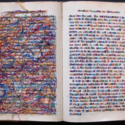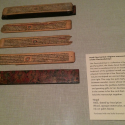The name neography implies that it refers to a new (neo-) form of writing (-graphy). But the truth is that this is a misnomer: Neography is nothing new. In fact, it’s as old as writing itself.
Mateo Maciá writes in his study on written language that the first Greek writings exhibited tremendous freedom in form, focusing as much on the graphic value of each letter as the phonetic value. Early Greek writers wrote indiscriminately from left to right, from right to left and in bustrophedon, in which a string of characters advances down the page in a zig-zag pattern, with each line alternating between left-to-right and right-to-left. You can read more about this in a recent article on Lexicon Valley that is, in itself, an excerpt of a recent book on written language by Keith Houston.
In time written language saw some standardization (with regard to direction, for example), but each individual writer still had a lot of freedom of visual expression. As I’ve written about before, there are uncountable ways to write each letter, and we each develop our own, unique handwriting scripts as we scribble our way through life.
But when the printing press came along, it squelched this type of individual paragraphemic expression. As Amalia Gnanadesikan writes in The Writing Revolution:
Different people have different handwriting … Individual Mycenaean or Carolingian scribes can still be identified by their work; not so the modern writer. With a single font, the e in one word will look just like the e in the next, no matter who originally authored the individual words. …
Inevitably, there were some who objected to the sterility of the new process. How could the spiritual value of a printed Bible possibly compare to that of one crafted by hand by a praying human soul?
If today’s neography is an attempt to recoup the personality lost in the transition to type, are we seeing a return to the writing of oral culture? In his book, Maciá lists a number of ways that our current writing culture reflects that of before the invention of the printing press:
- Concept of scroll (which reminds us of scrolls that were around before modern pages)
- Predominance of copulative sentences instead of subordinations
- Fixed formulas that are no longer analyzed for their literal meaning (lol, for example)
- Integration of text and images
- Homeostasis (dictionaries are consulted less in neographic writing, meaning that words are defined in running context)
- Multilingualism
- Change of support (whereas typography has only occurred on paper, other writing has used a myriad of supports)
- Rewriteability
- Proliferation of audiovisual communities along with textual communities
- Predominance of orality in public communication
- Mobility of information
- Public (rather than individual) storage of information
- Lacking policies of control and governance (innovations can surface anywhere)
Clearly we have readopted many aspects of oral culture. But we don’t truly have an oral culture. Our laws are still written, for example, and written contracts are final. And, after all, though our writing does encroach upon speech, it is inarguably still written. So where does that leave us? We’ve got a print culture with many aspects of oral culture—amidst a heterogeneous culture clash.
 Follow
Follow

